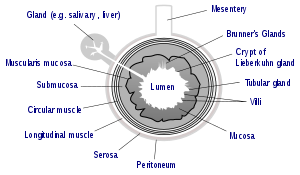In human anatomy, the intestine (or bowel) is the segment of the alimentary canal extending from the pyloric sphincter of the stomach to the anus and, in humans and other mammals, consists of two segments, the small intestine and the large intestine. In humans, the small intestine is further subdivided into the duodenum, jejunum and ileum while the large intestine is subdivided into the cecum and colon.[1]
The structure and function can be described both as gross anatomy
and at a microscopic level. The intestinal tract can be broadly divided
into two different parts, the small and large intestine. .[2] People will have different sized intestines according to their size and age.
The lumen is the cavity where digested food passes through and from where nutrients are absorbed. Both intestines share a general structure with the whole gut, and are composed of several layers. Going from inside the lumen radially outwards, one passes the mucosa (glandular epithelium and muscularis mucosa), submucosa, muscularis externa (made up of inner circular and outer longitudinal), and lastly serosa.

Structure and function
The lumen is the cavity where digested food passes through and from where nutrients are absorbed. Both intestines share a general structure with the whole gut, and are composed of several layers. Going from inside the lumen radially outwards, one passes the mucosa (glandular epithelium and muscularis mucosa), submucosa, muscularis externa (made up of inner circular and outer longitudinal), and lastly serosa.
 |
| The general structure of the intestinal wall |

Along the whole length of the gut in the glandular epithelium are goblet cells. These secrete mucus which lubricates the passage of food along and protects it from digestive enzymes. In the small intestine, villi are vaginations (folds) of the mucosa and increase the overall surface area of the intestine while also containing a lacteal, which is connected to the lymph system and aids in the removal of lipids
and tissue fluid from the blood supply. Microvilli are present on the
epithelium of a villus and further increase the surface area over which
absorption can take place. Pocket-like invaginations into the underlying
tissue are termed Crypts_of_Lieberkühn. In the large intestines, villi are absent and a flat surface with thousands of crypts is observed.
- Underlying the epithelium is the lamina propria, which contains myofibroblasts, blood vessels, nerves, and several different immune cells.
- The next layer is the muscularis mucosa which is a layer of smooth muscle that aids in the action of continued peristalsis and catastalsis along the gut. The submucosa contains nerves (e.g. Meissner's plexus), blood vessels and elastic fibre with collagen that stretches with increased capacity but maintains the shape of the intestine.
- Surrounding this is the muscularis externa which comprises longitudinal and circular smooth muscle that again helps with continued peristalsis and the movement of digested material out of and along the gut. In between the two layers of muscle lies Auerbach's plexus.
- Lastly there is the serosa which is made up of loose connective tissue and coated in mucus so as to prevent friction damage from the intestine rubbing against other tissue. Holding all this in place are the mesenteries which suspend the intestine in the abdominal cavity and stop it being disturbed when a person is physically active.
Diseases and disorders
- Gastroenteritis is an inflammation of the intestines. It is the most common disease of all the intestines.
- Ileus is a blockage of the intestines.
- Ileitis is an inflammation of the ileum.
- Colitis is an inflammation of the large intestine.
- Appendicitis is inflammation of the vermiform appendix located at the caecum. This is a potentially fatal disease if left untreated; most cases of appendicitis require surgical intervention.
- Coeliac disease is a common form of malabsorption, affecting up to 1% of people of northern European descent. An autoimmune response is triggered in intestinal cells by digestion of gluten proteins. Ingestion of proteins found in wheat, barley and rye, causes villous atrophy in the small intestine. Life-long dietary avoidance of these foodstuffs in a gluten-free diet is the only treatment.
- Crohn's disease and ulcerative colitis are examples of inflammatory bowel disease. While Crohn's can affect the entire gastrointestinal tract, ulcerative colitis is limited to the large intestine. Crohn's disease is widely regarded as an autoimmune disease. Although ulcerative colitis is often treated as though it were an autoimmune disease, there is no consensus that it actually is such. (See List of autoimmune diseases).
- Enteroviruses are named by their transmission-route through the intestine (enteric meaning intestinal), but their symptoms aren't mainly associated with the intestine.
- Irritable bowel syndrome (IBS) is the most common functional disorder of the intestine. Functional constipation and chronic functional abdominal pain are other disorders of the intestine that have physiological causes, but do not have identifiable structural, chemical, or infectious pathologies. They are aberrations of normal bowel function but not diseases.[3]
- Diverticular disease is a condition that is very common in older people in industrialized countries. It usually affects the large intestine but has been known to affect the small intestine as well. Diverticulosis occurs when pouches form on the intestinal wall. Once the pouches become inflamed it is known as diverticulitis.
- Endometriosis can affect the intestines, with similar symptoms to IBS.
- Bowel twist (or similarly, bowel strangulation) is a comparatively rare event (usually developing sometime after major bowel surgery). It is, however, hard to diagnose correctly, and if left uncorrected can lead to bowel infarction and death. (The singer Maurice Gibb is understood to have died from this.)
- Angiodysplasia of the colon
- Chronic functional abdominal pain
- Colorectal cancer
- Constipation
- Diarrhea
- Hirschsprung's disease (aganglionosis)
- Intussusception
- Polyp (medicine) (see also Colorectal polyp)
- Pseudomembranous colitis
- Ulcerative colitis and toxic megacolon
No comments:
Post a Comment